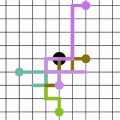Recommender systems typically suggest to users content similar to what they consumed in the past. If a user happens to be exposed to strongly polarized content, she might subsequently receive recommendations which may steer her towards more and more radicalized content, eventually being trapped in what we call a "radicalization pathway". In this paper, we study the problem of mitigating radicalization pathways using a graph-based approach. Specifically, we model the set of recommendations of a "what-to-watch-next" recommender as a d-regular directed graph where nodes correspond to content items, links to recommendations, and paths to possible user sessions. We measure the "segregation" score of a node representing radicalized content as the expected length of a random walk from that node to any node representing non-radicalized content. High segregation scores are associated to larger chances to get users trapped in radicalization pathways. Hence, we define the problem of reducing the prevalence of radicalization pathways by selecting a small number of edges to "rewire", so to minimize the maximum of segregation scores among all radicalized nodes, while maintaining the relevance of the recommendations. We prove that the problem of finding the optimal set of recommendations to rewire is NP-hard and NP-hard to approximate within any factor. Therefore, we turn our attention to heuristics, and propose an efficient yet effective greedy algorithm based on the absorbing random walk theory. Our experiments on real-world datasets in the context of video and news recommendations confirm the effectiveness of our proposal.
翻译:推荐者系统通常会向用户推荐类似于过去消费的内容。 如果用户碰巧暴露于极极化的内容中, 她可能会随后收到一些建议, 这些建议可能会引导她走向更多、更激进的内容, 最终被困在我们所谓的“ 激进化路径” 中。 在本文中, 我们用图表方法研究减缓激进化路径的问题。 具体地说, 我们用“ 什么样的观察- 下一步” 的建议作为一套“ 常规定向图表” 的模型, 其节点与内容项目、 建议链接和可能的用户会话路径相对应。 我们测量“ 分离” 节点的得分“ 分离”, 表示激进化内容的预期长度, 从这个节点到任何代表非激进化内容的节点。 高隔离得分与让用户陷入激进化路径的更大机会有关。 因此, 我们把“ 什么观察者观察者-观察者- ” 的建议作为“ ” 的固定方向, 以便尽可能减少所有激进的节点之间的分数, 同时保持建议的相关性。 我们证明, 找到我们最坏的轨道上的最佳数据 。



